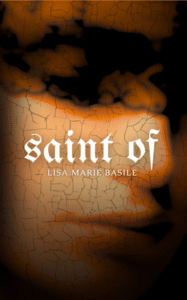
Lisa Marie Basile discovers saints of some unusual things
I had a college roommate who wore a St. Christopher medal around his neck. The saint, who lived in the second or third century A.D., is the patron saint of travelers, among other things. My roommate wasn’t Catholic, but he was quite fond of his medal, claiming it protected him when driving to and from college, about four hours each way. And then he read that the church had dropped St. Christopher’s annual July 25 commemoration. A reorganization of the church calendar had been undertaken, and relatively recent commemorations were dropped. The one for St. Christopher had only begun in 1550.
My roommate was mournful. “I’m still wearing my medal,” he’d say, “but I guess I have to call him Mr. Christopher now.”
That story of “Mr. Christopher” came to mind as I read Saint Of: Poems, the new collection by Lisa Marie Basile. She, too, has saints for whom there are no annual commemorations. These saints have no official days, and, in fact, don’t even have names. But they are titles for poems, and every title is something familiar.
Basile has saints for erasure, unbelonging, orphaned girls, women’s shelters, collateral damage, uprooting, self-defeat, tenebrous things, fixation reverie, blight, ruination, summer sorrows, control, artifice, sea change, lament, reckoning, approval, and reclamation, to mention only a few. The saints are found in the titles; each poem tells a story not of a saint but a life story, event, or remembrance. Using “saint of” for each title implies a sacredness to life, even when it’s difficult to see the sacred in something, like ruination or self-defeat. Nevertheless, Basile finds it, even in life’s gaps.
With roots
who would I have been?
I was slipped off like satin.
And suddenly it was two decades later
with the same emptiness.
What girl can know the abyss
without becoming it?
It is easy to give in to the prowl,
to stain the coverlet
come June mornings
in the blue breeze
in the loom of eternal afternoons.
The promise of revelation
is a body
is a chapel
is a return to somewhere home-shaped.
How do you hold a thing when you’ve never known
the contained?
Several of the poems reflect Basile’s interest in foster children, women’s issues, and chronic illness awareness. All of the poems read easily, even when the subjects (or “saints”) are difficult. She has a keen eye for the things that go wrong in life, and yet the poems suggest there is always hope.

Lisa Marie Basile
Basile, based in New York City, has previously published several poetry collections and nonfiction books, including Nympholepsy, Apocryphal, Andalucia, and Light Magic for Dark Times. Her poems and writing have been published in several literary journals and newspapers and included in such anthologies as Best Small Fictions and Best American Experimental Writing. A workshop leader and founding editor of Luna Luna Magazine, she received her MFA degree in writing from The New School in New York City.
If you want to meet saints you didn’t know existed, Saint Of is a good place to start. Basile’s saints may never be recognized or commemorated by any church, but we all know them for the large and small roles they play in life, including our own.
Photo by Donnie Nunley, Creative Commons, via Flickr. Post by Glynn Young.
How to Read a Poem uses images like the mouse, the hive, the switch (from the Billy Collins poem)—to guide readers into new ways of understanding poems. Anthology included.
“I require all our incoming poetry students—in the MFA I direct—to buy and read this book.”
—Jeanetta Calhoun Mish
- Poets and Poems: Donna Vorreyer and “Unrivered” - October 7, 2025
- Poet Sidney Lanier and the Lost Cause - October 2, 2025
- Poets and Poems: A.J. Thibault and “We Lack a Word” - September 30, 2025


Leave a Reply